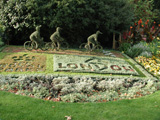Learning To Love Virtual Exhibitions – 2020 By Abby Cronin
Originally published in October 2020 in American in Britain, Autumn 2020
When the lockdown began in mid-March this year, many of us suddenly woke up to a stay-at-home routine and lifestyle. Our daily habits changed. But don’t despair. There is a wealth of virtual art and antiques out there to satisfy your taste and curiosity. Go online in the comfort of your home and meet the exhibitions and galleries remotely. The virtual exhibition is literally at your fingertips.
Learning to Love Virtual Exhibitions – 2020
When the lockdown began in mid-March this year, many of us suddenly woke up to a stay-at-home routine and lifestyle. Our daily habits changed overnight. Any plan for stepping out into town to visit that blockbuster exhibition, Picasso and Paper, at the Royal Academy was put ‘on hold’. If you were planning to attend the June Art & Antiques Fair at Olympia London, unfortunately it was postponed due to Government guidelines following COVID-19. But don’t despair. There is a wealth of virtual art and antiques out there to satisfy your taste and curiosity. Go online in the comfort of your home. Check out the Art & Antiques Olympia website and take their virtual tour. Meet the galleries remotely. Still interested? Then you’ll have to wait to see if dates for the November 2020 Winter Olympia Fair will go ahead. While you wait for museums, galleries, fairs and auctions to open up, when they do, new visiting conditions will mean more regimented visits. Everyone will need to book ahead, ensure social distancing on site and wear a mask. But if you’re someone who is cautious about travelling during lockdown, why not just be there online? It seems that virtual exhibitions are 2020’s ‘new normal’.
An early victim of the lockdown was the Kimono: Kyoto to Catwalk show at the Victoria and Albert museum. Originally scheduled to open in February 2020, it had to close when the V&A shut down in March. But now there is good news! This brilliant exhibition has reopened. And a wealth of information about it is accessible online. In keeping with the V&A’s recent show-stopping fashion exhibits – notably Dior, Mary Quant and McQueen, this is truly an exceptional show. For starters you will learn that Kimono, a term first adopted in the mid-19th century Japan, simply means “the thing to wear”. It describes a classic Japanese garment. A Kimono is a simple, straight-seamed piece of fabric that is worn wrapped left side over right and secured with a sash called an obi. The exhibit charts the evolution of the kimono from its origins in the 1660s to present day. It features kimonos as dynamic and evolving garments both in Japan and the rest of the world.
Before the museum closed its doors in March the V&A made a series of five films of the Kimono: Kyoto to Catwalk exhibition. You can view the films on YouTube (Kimono: Kyoto to Catwalk) and enjoy learning about Kimono with the curator Anna Jackson. She takes us through the different galleries and explains the history of kimono and its iconic status in Japanese culture. Over 315 works are featured in this truly remarkable exhibition. Kimono is, Jackson tells us, essentially a unisex garment worn by men, women and children. Until now the V&A fashion exhibits have focused on western designers but here we learn how the kimono has influenced global fashions. Look out for a new wave of design in contemporary kimono fashion. There are several original examples such as the kimono designed by maverick John Galliano, the garment worn by Alec Guinness as Obi-wan Kenobi in the Star Wars film and Bjork’s kimono by Alexander McQueen. Today Kimono has assumed an evolving status. Anna Jackson tells us: “From the sophisticated culture of 17th Kyoto to the creativity of the contemporary catwalk, the kimono has been subject to local and global reinvention earning it a fascinating place in the story of international fashion.”
Museum and gallery virtual tours have mushroomed during the period of lockdown. So if you find yourself at loose ends on a rainy afternoon take a cup of tea and relax in front of your computer. All you need to do is logon to any one of London’s numerous museums and gallery websites where you will find their videos and virtual tours. The Royal Academy of Art has several and they all have first class production values. Archival material is often available. If you missed the remarkable Picasso and Paper exhibition before it closed with the lockdown and re-opened briefly in the summer months, you can still see it. Go online to the RA website. A comprehensive curatorial video tour of this exhibition is easy to access. Curator Ann Dumas escorts viewers around the gallery and explains how Picasso innovated by tearing, sculpting, burning and collaging with any paper he came across. It’s a special treat—even if you were fortunate enough to visit this show in person. Stay online at the RA a little longer to view a documentary made in 1956: ‘Watch Picasso Make a Masterpiece’. https://www.youtube.com/watch?v=Nxes8pyHkJc; https://www.facebook.com/watch/?v=1327743584084590 https://www.royalacademy.org.uk/search-results?q=Video+Picassso+and+Paper
While you’re on the RA website, go inside the exhibition: Gauguin and the Impressionists with curatorial narration. All of this is art literally at your fingertips.
Stay online and head over to view the popular Andy Warhol exhibition on Tate Modern’s website. https://www.tate.org.uk/whats-on/tate-modern/exhibition/andy-warhol
Click on the Andy Warhol exhibition. Suddenly you are back in the heady and artistic 60s and 70s decades in New York City. Watch the excellent curatorial tour with Muir and Moran. They discuss Warhol through the lens of his immigrant story, his LGBTQI identity and preoccupation with death and religion. Their narration unpacks the depth and complexity of Warhol’s subject matter and his innovative experiments with media. It’s a compelling view of Warhol’s flamboyant personal life. Warhol at Tate Modern closes on 15th November. Try to squeeze in a visit to see this retrospective. While there, don’t forget to admire his famous Cow Wallpaper featuring a fluorescent pink cow installed in the exhibition café level 6.
Today the world of virtual exhibitions, galleries, fairs and auctions is literally global. But finding one that suits your taste may take quite a bit of surfing. Be patient. You need to try the virtual on, so to speak. Not everyone is keen to pursue their artistic tastes this way. One writer has described the virtual tour as a “grand term for these lonely digital ‘experiences’. So- before clicking a link, ask: is the virtual exhibition designed as an introductory overview or an in-depth, focused one? Was it made for a museum, an independent gallery, auction house or is it essentially commercial advertising? A good example of a virtual introductory overview can be found on New York’s Metropolitan Museum of Art’s website. https://www.metmuseum.org/ New visitors to the MET website are offered an almost hour long comprehensive journey through its galleries, with brief glimpses of different historic periods, paintings and objects. The tour includes comments from specialist curators and the museum director. It provides a virtual/visual map for first-time visitors. As a general overview it opens the MET’s door and puts out the welcome mat.
By contrast, smaller galleries, auctions and fairs may be more satisfying because they focus on specific artists, their biographies and show their work. A good example of a smaller private gallery is Eames Fine Art established in 2013. https://www.eamesfineart.com If the lockdown keeps you at home, enjoy surfing through their website where you will meet both established and contemporary artists. Their film archive is seriously informative – almost a series of lectures in art history. Look out for their online auctions of works of art. The gallery is easily accessible on Bermondsey Street, SW1 near the SHARD. By contrast is THE NET GALLERY https://thenetgallery.com/ uses state of the art technology which offers a virtual gallery experience and brings exhibitions to life. 3D exhibitions at The Net Gallery take you up close to the work using 3D scans. This fascinating technology is used by the Halcyon Gallery on Bond Street. https://www.halcyongallery.com/galleries/29-new-bond-street Halcyon offers a virtual experience which takes you into the gallery where viewers can scan art in the different rooms. We all love auctions. They can be global or local: both high (such as Sothebys, Christies) and low end like Criterion online listings in London. They have weekly sales. https://www.criterionauctioneers.com/auctions/ Whether you learn to love virtual exhibitions or not, when real life re-emerges, post lockdown, as art lovers we will again cherish that unique personal relationship with art, an experience which only comes when we engage with the work face to face.
_____________________________________________________________
Do Get in Touch
Contact: Abby Cronin
Email: artsjournalist@abbycronin.co.uk
Website: abbycronin.co.uk
Photos Courtesy V&A Press & Abby Cronin
KIMONO exhibit at V&A closes Sunday 25 October 2020
ANDY WARHOL at Tate Modern closes 15 November 2020




